Principles of Case Management: A Case Study of Leticia and Dashon
VerifiedAdded on 2022/10/06
|10
|1996
|42
Report
AI Summary
This report delves into the principles of case management, utilizing the case study of "Leticia and Dashon" to illustrate key concepts. It examines group roles, negotiation and leadership skills, responses to feedback, conflict management, reflective listening, organizational and time management, and equal contribution within the context of healthcare services. The analysis considers the challenges faced by Leticia, a mother in recovery from drug addiction, and her concerns for her son's future. The report highlights the importance of case management in providing comprehensive care, coordinating services, and addressing the complex needs of individuals and families navigating healthcare systems. The discussion includes the significance of community-based approaches, drug rehabilitation, and the ethical considerations involved in supporting vulnerable populations. The study emphasizes the need for effective communication, conflict resolution, and time management to ensure successful outcomes in case management practices.

Running head: Principals of Case management
Principals of Case management
Principals of Case management
Paraphrase This Document
Need a fresh take? Get an instant paraphrase of this document with our AI Paraphraser
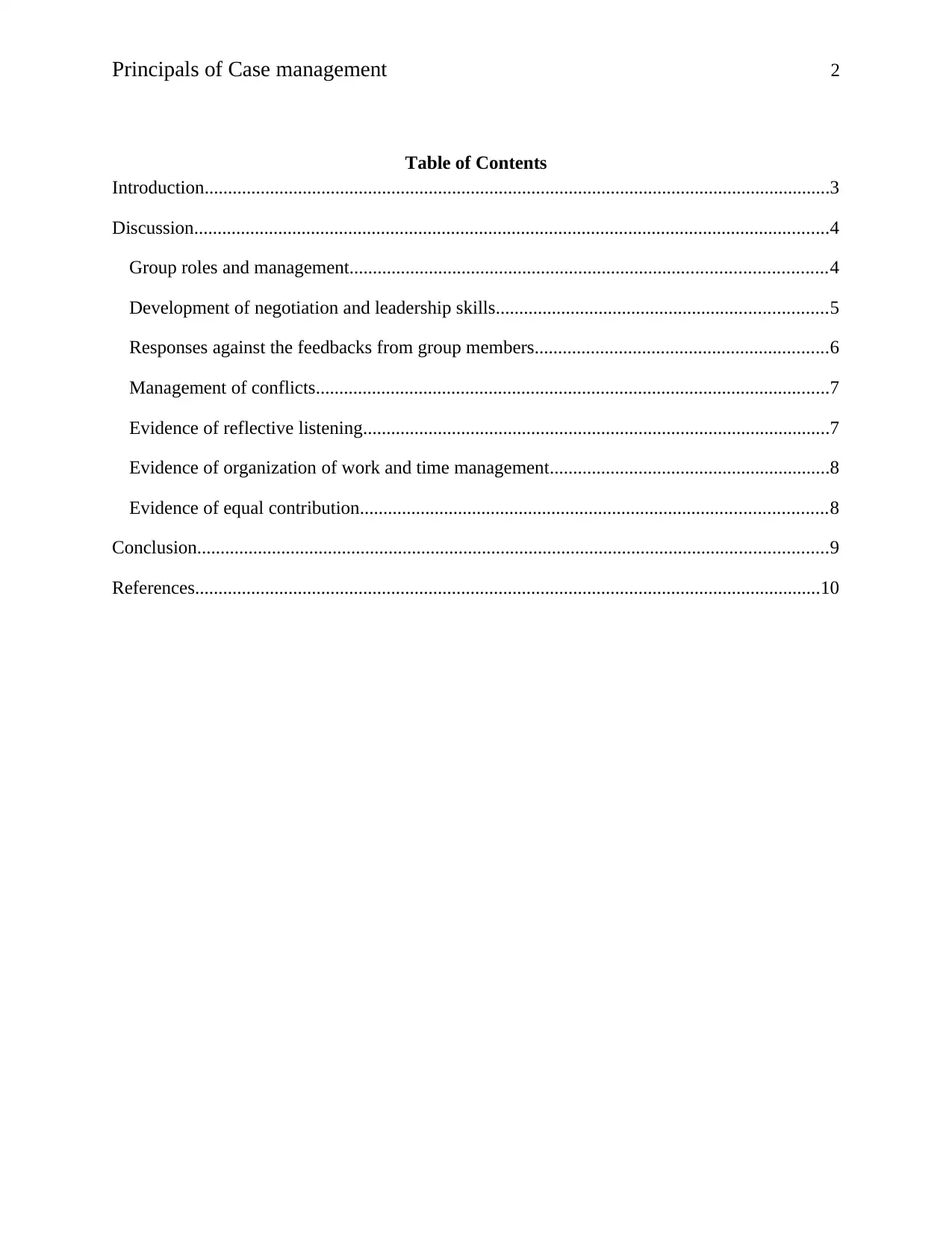
Principals of Case management 2
Table of Contents
Introduction......................................................................................................................................3
Discussion........................................................................................................................................4
Group roles and management......................................................................................................4
Development of negotiation and leadership skills.......................................................................5
Responses against the feedbacks from group members...............................................................6
Management of conflicts..............................................................................................................7
Evidence of reflective listening....................................................................................................7
Evidence of organization of work and time management............................................................8
Evidence of equal contribution....................................................................................................8
Conclusion.......................................................................................................................................9
References......................................................................................................................................10
Table of Contents
Introduction......................................................................................................................................3
Discussion........................................................................................................................................4
Group roles and management......................................................................................................4
Development of negotiation and leadership skills.......................................................................5
Responses against the feedbacks from group members...............................................................6
Management of conflicts..............................................................................................................7
Evidence of reflective listening....................................................................................................7
Evidence of organization of work and time management............................................................8
Evidence of equal contribution....................................................................................................8
Conclusion.......................................................................................................................................9
References......................................................................................................................................10
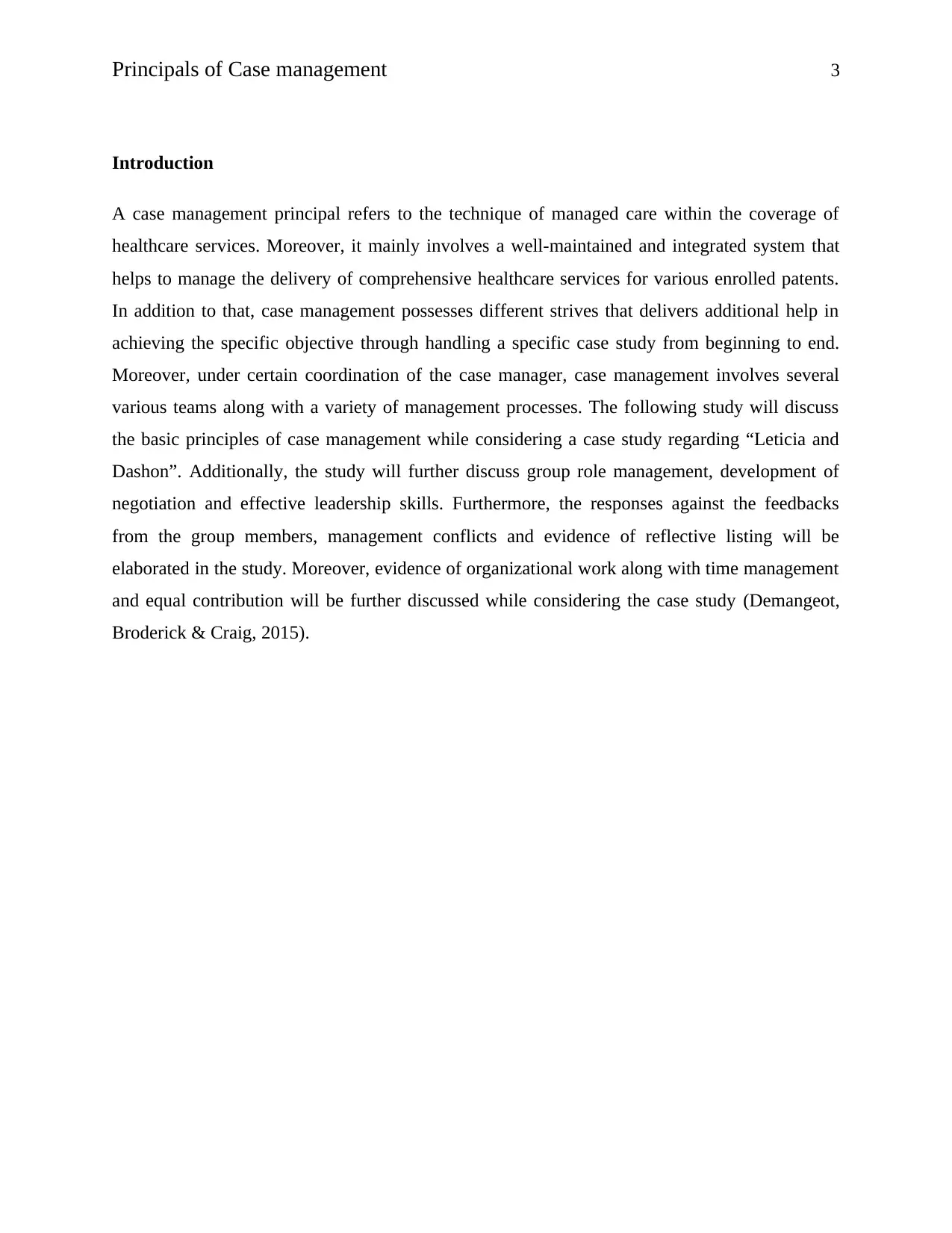
Principals of Case management 3
Introduction
A case management principal refers to the technique of managed care within the coverage of
healthcare services. Moreover, it mainly involves a well-maintained and integrated system that
helps to manage the delivery of comprehensive healthcare services for various enrolled patents.
In addition to that, case management possesses different strives that delivers additional help in
achieving the specific objective through handling a specific case study from beginning to end.
Moreover, under certain coordination of the case manager, case management involves several
various teams along with a variety of management processes. The following study will discuss
the basic principles of case management while considering a case study regarding “Leticia and
Dashon”. Additionally, the study will further discuss group role management, development of
negotiation and effective leadership skills. Furthermore, the responses against the feedbacks
from the group members, management conflicts and evidence of reflective listing will be
elaborated in the study. Moreover, evidence of organizational work along with time management
and equal contribution will be further discussed while considering the case study (Demangeot,
Broderick & Craig, 2015).
Introduction
A case management principal refers to the technique of managed care within the coverage of
healthcare services. Moreover, it mainly involves a well-maintained and integrated system that
helps to manage the delivery of comprehensive healthcare services for various enrolled patents.
In addition to that, case management possesses different strives that delivers additional help in
achieving the specific objective through handling a specific case study from beginning to end.
Moreover, under certain coordination of the case manager, case management involves several
various teams along with a variety of management processes. The following study will discuss
the basic principles of case management while considering a case study regarding “Leticia and
Dashon”. Additionally, the study will further discuss group role management, development of
negotiation and effective leadership skills. Furthermore, the responses against the feedbacks
from the group members, management conflicts and evidence of reflective listing will be
elaborated in the study. Moreover, evidence of organizational work along with time management
and equal contribution will be further discussed while considering the case study (Demangeot,
Broderick & Craig, 2015).
⊘ This is a preview!⊘
Do you want full access?
Subscribe today to unlock all pages.

Trusted by 1+ million students worldwide
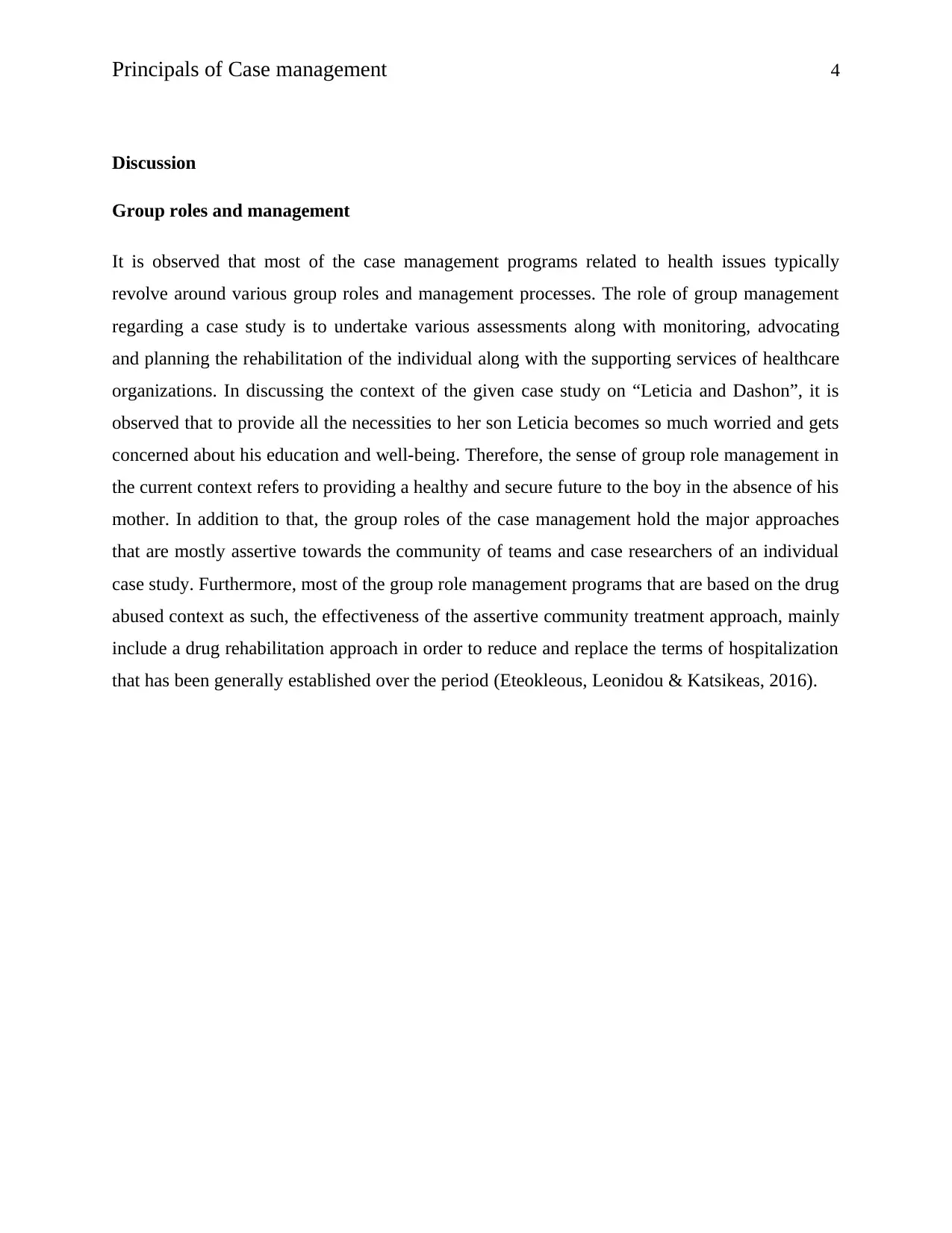
Principals of Case management 4
Discussion
Group roles and management
It is observed that most of the case management programs related to health issues typically
revolve around various group roles and management processes. The role of group management
regarding a case study is to undertake various assessments along with monitoring, advocating
and planning the rehabilitation of the individual along with the supporting services of healthcare
organizations. In discussing the context of the given case study on “Leticia and Dashon”, it is
observed that to provide all the necessities to her son Leticia becomes so much worried and gets
concerned about his education and well-being. Therefore, the sense of group role management in
the current context refers to providing a healthy and secure future to the boy in the absence of his
mother. In addition to that, the group roles of the case management hold the major approaches
that are mostly assertive towards the community of teams and case researchers of an individual
case study. Furthermore, most of the group role management programs that are based on the drug
abused context as such, the effectiveness of the assertive community treatment approach, mainly
include a drug rehabilitation approach in order to reduce and replace the terms of hospitalization
that has been generally established over the period (Eteokleous, Leonidou & Katsikeas, 2016).
Discussion
Group roles and management
It is observed that most of the case management programs related to health issues typically
revolve around various group roles and management processes. The role of group management
regarding a case study is to undertake various assessments along with monitoring, advocating
and planning the rehabilitation of the individual along with the supporting services of healthcare
organizations. In discussing the context of the given case study on “Leticia and Dashon”, it is
observed that to provide all the necessities to her son Leticia becomes so much worried and gets
concerned about his education and well-being. Therefore, the sense of group role management in
the current context refers to providing a healthy and secure future to the boy in the absence of his
mother. In addition to that, the group roles of the case management hold the major approaches
that are mostly assertive towards the community of teams and case researchers of an individual
case study. Furthermore, most of the group role management programs that are based on the drug
abused context as such, the effectiveness of the assertive community treatment approach, mainly
include a drug rehabilitation approach in order to reduce and replace the terms of hospitalization
that has been generally established over the period (Eteokleous, Leonidou & Katsikeas, 2016).
Paraphrase This Document
Need a fresh take? Get an instant paraphrase of this document with our AI Paraphraser
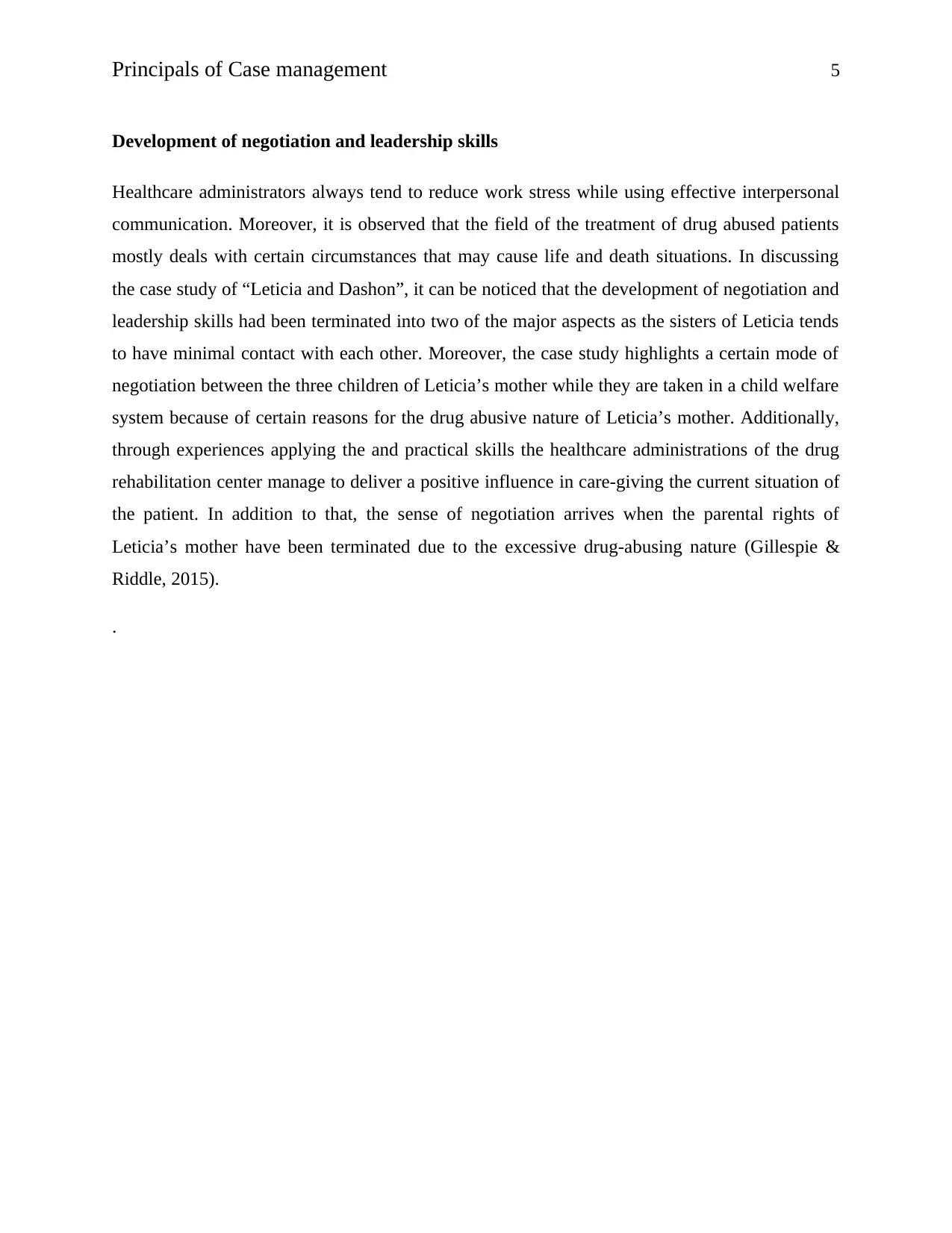
Principals of Case management 5
Development of negotiation and leadership skills
Healthcare administrators always tend to reduce work stress while using effective interpersonal
communication. Moreover, it is observed that the field of the treatment of drug abused patients
mostly deals with certain circumstances that may cause life and death situations. In discussing
the case study of “Leticia and Dashon”, it can be noticed that the development of negotiation and
leadership skills had been terminated into two of the major aspects as the sisters of Leticia tends
to have minimal contact with each other. Moreover, the case study highlights a certain mode of
negotiation between the three children of Leticia’s mother while they are taken in a child welfare
system because of certain reasons for the drug abusive nature of Leticia’s mother. Additionally,
through experiences applying the and practical skills the healthcare administrations of the drug
rehabilitation center manage to deliver a positive influence in care-giving the current situation of
the patient. In addition to that, the sense of negotiation arrives when the parental rights of
Leticia’s mother have been terminated due to the excessive drug-abusing nature (Gillespie &
Riddle, 2015).
.
Development of negotiation and leadership skills
Healthcare administrators always tend to reduce work stress while using effective interpersonal
communication. Moreover, it is observed that the field of the treatment of drug abused patients
mostly deals with certain circumstances that may cause life and death situations. In discussing
the case study of “Leticia and Dashon”, it can be noticed that the development of negotiation and
leadership skills had been terminated into two of the major aspects as the sisters of Leticia tends
to have minimal contact with each other. Moreover, the case study highlights a certain mode of
negotiation between the three children of Leticia’s mother while they are taken in a child welfare
system because of certain reasons for the drug abusive nature of Leticia’s mother. Additionally,
through experiences applying the and practical skills the healthcare administrations of the drug
rehabilitation center manage to deliver a positive influence in care-giving the current situation of
the patient. In addition to that, the sense of negotiation arrives when the parental rights of
Leticia’s mother have been terminated due to the excessive drug-abusing nature (Gillespie &
Riddle, 2015).
.
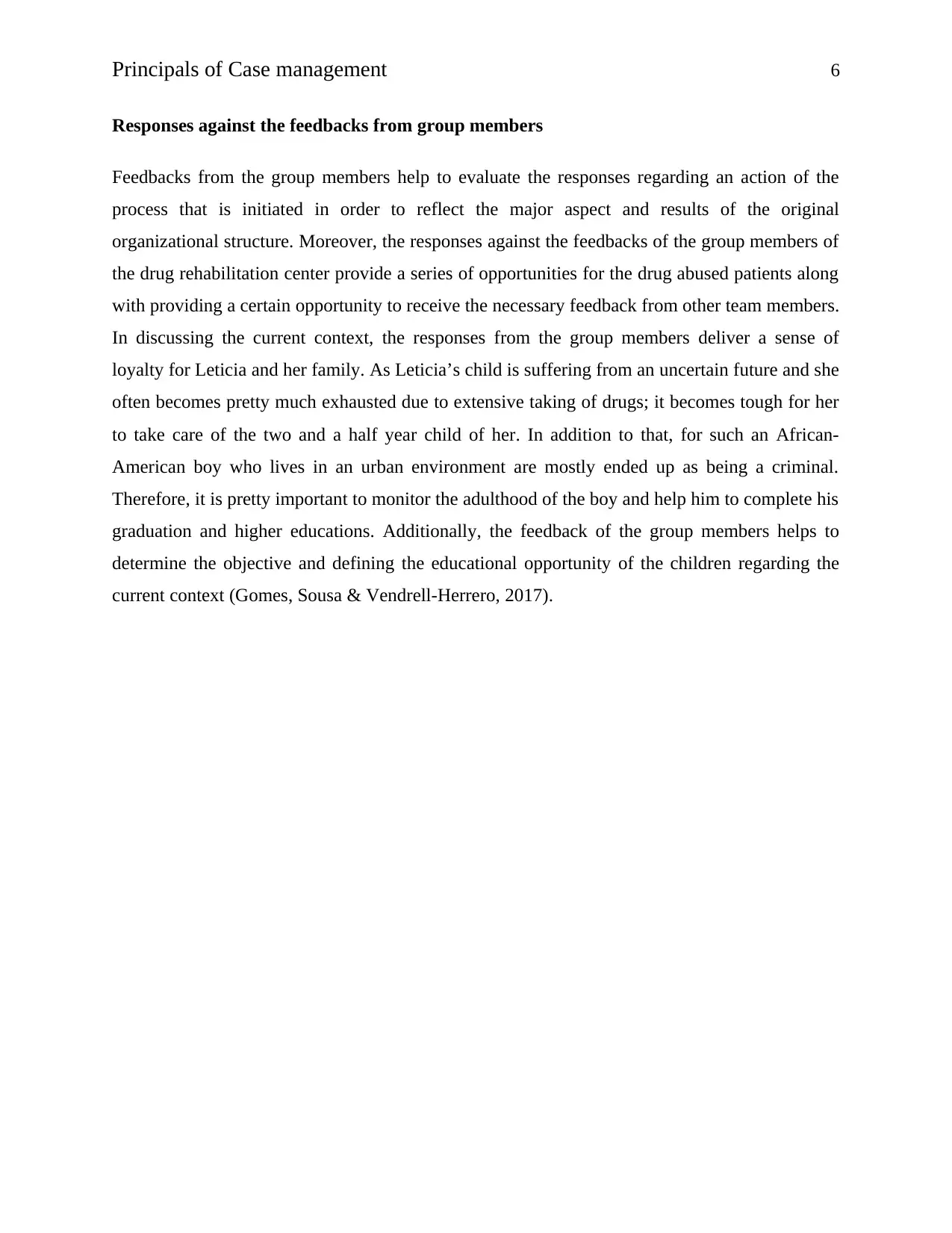
Principals of Case management 6
Responses against the feedbacks from group members
Feedbacks from the group members help to evaluate the responses regarding an action of the
process that is initiated in order to reflect the major aspect and results of the original
organizational structure. Moreover, the responses against the feedbacks of the group members of
the drug rehabilitation center provide a series of opportunities for the drug abused patients along
with providing a certain opportunity to receive the necessary feedback from other team members.
In discussing the current context, the responses from the group members deliver a sense of
loyalty for Leticia and her family. As Leticia’s child is suffering from an uncertain future and she
often becomes pretty much exhausted due to extensive taking of drugs; it becomes tough for her
to take care of the two and a half year child of her. In addition to that, for such an African-
American boy who lives in an urban environment are mostly ended up as being a criminal.
Therefore, it is pretty important to monitor the adulthood of the boy and help him to complete his
graduation and higher educations. Additionally, the feedback of the group members helps to
determine the objective and defining the educational opportunity of the children regarding the
current context (Gomes, Sousa & Vendrell-Herrero, 2017).
Responses against the feedbacks from group members
Feedbacks from the group members help to evaluate the responses regarding an action of the
process that is initiated in order to reflect the major aspect and results of the original
organizational structure. Moreover, the responses against the feedbacks of the group members of
the drug rehabilitation center provide a series of opportunities for the drug abused patients along
with providing a certain opportunity to receive the necessary feedback from other team members.
In discussing the current context, the responses from the group members deliver a sense of
loyalty for Leticia and her family. As Leticia’s child is suffering from an uncertain future and she
often becomes pretty much exhausted due to extensive taking of drugs; it becomes tough for her
to take care of the two and a half year child of her. In addition to that, for such an African-
American boy who lives in an urban environment are mostly ended up as being a criminal.
Therefore, it is pretty important to monitor the adulthood of the boy and help him to complete his
graduation and higher educations. Additionally, the feedback of the group members helps to
determine the objective and defining the educational opportunity of the children regarding the
current context (Gomes, Sousa & Vendrell-Herrero, 2017).
⊘ This is a preview!⊘
Do you want full access?
Subscribe today to unlock all pages.

Trusted by 1+ million students worldwide
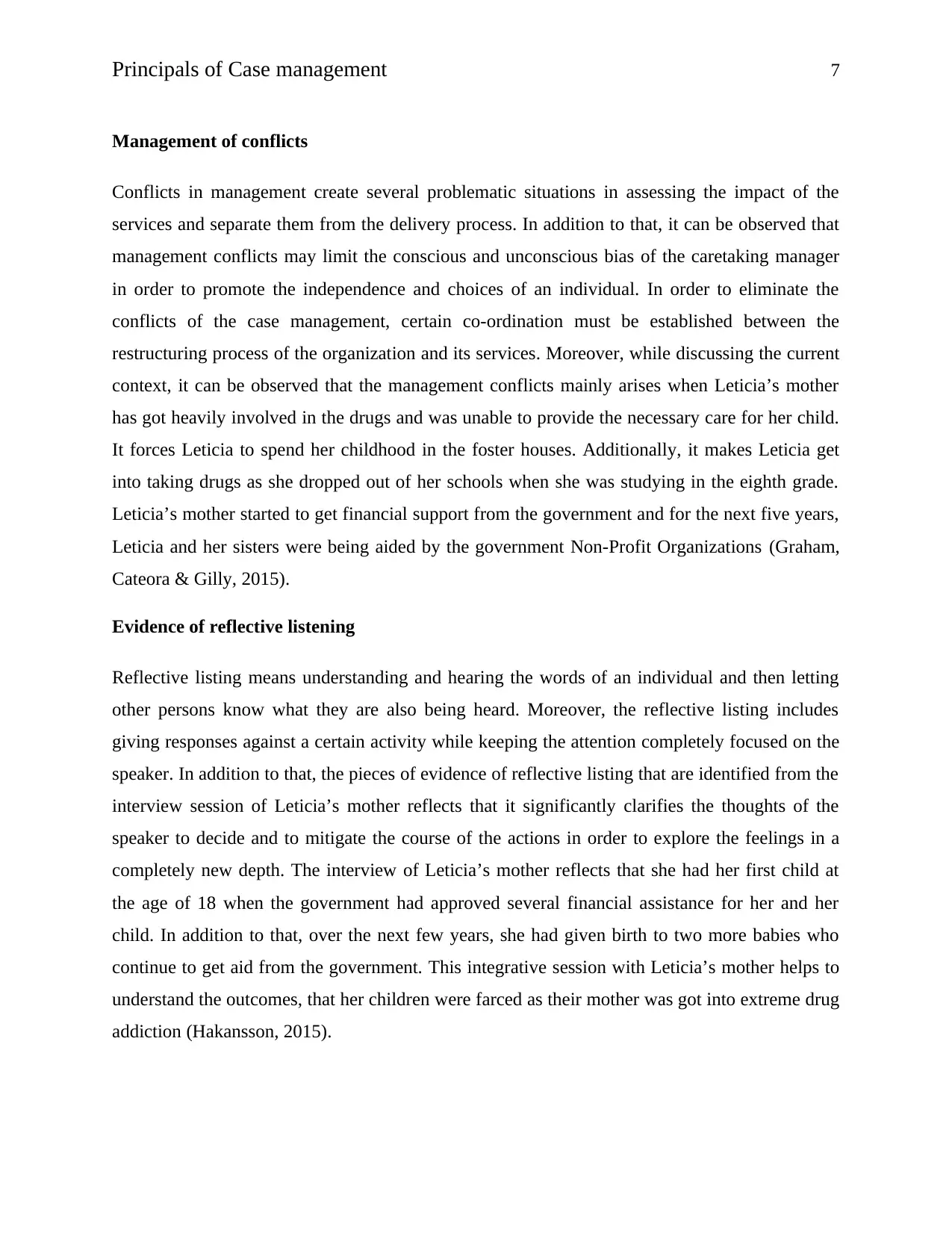
Principals of Case management 7
Management of conflicts
Conflicts in management create several problematic situations in assessing the impact of the
services and separate them from the delivery process. In addition to that, it can be observed that
management conflicts may limit the conscious and unconscious bias of the caretaking manager
in order to promote the independence and choices of an individual. In order to eliminate the
conflicts of the case management, certain co-ordination must be established between the
restructuring process of the organization and its services. Moreover, while discussing the current
context, it can be observed that the management conflicts mainly arises when Leticia’s mother
has got heavily involved in the drugs and was unable to provide the necessary care for her child.
It forces Leticia to spend her childhood in the foster houses. Additionally, it makes Leticia get
into taking drugs as she dropped out of her schools when she was studying in the eighth grade.
Leticia’s mother started to get financial support from the government and for the next five years,
Leticia and her sisters were being aided by the government Non-Profit Organizations (Graham,
Cateora & Gilly, 2015).
Evidence of reflective listening
Reflective listing means understanding and hearing the words of an individual and then letting
other persons know what they are also being heard. Moreover, the reflective listing includes
giving responses against a certain activity while keeping the attention completely focused on the
speaker. In addition to that, the pieces of evidence of reflective listing that are identified from the
interview session of Leticia’s mother reflects that it significantly clarifies the thoughts of the
speaker to decide and to mitigate the course of the actions in order to explore the feelings in a
completely new depth. The interview of Leticia’s mother reflects that she had her first child at
the age of 18 when the government had approved several financial assistance for her and her
child. In addition to that, over the next few years, she had given birth to two more babies who
continue to get aid from the government. This integrative session with Leticia’s mother helps to
understand the outcomes, that her children were farced as their mother was got into extreme drug
addiction (Hakansson, 2015).
Management of conflicts
Conflicts in management create several problematic situations in assessing the impact of the
services and separate them from the delivery process. In addition to that, it can be observed that
management conflicts may limit the conscious and unconscious bias of the caretaking manager
in order to promote the independence and choices of an individual. In order to eliminate the
conflicts of the case management, certain co-ordination must be established between the
restructuring process of the organization and its services. Moreover, while discussing the current
context, it can be observed that the management conflicts mainly arises when Leticia’s mother
has got heavily involved in the drugs and was unable to provide the necessary care for her child.
It forces Leticia to spend her childhood in the foster houses. Additionally, it makes Leticia get
into taking drugs as she dropped out of her schools when she was studying in the eighth grade.
Leticia’s mother started to get financial support from the government and for the next five years,
Leticia and her sisters were being aided by the government Non-Profit Organizations (Graham,
Cateora & Gilly, 2015).
Evidence of reflective listening
Reflective listing means understanding and hearing the words of an individual and then letting
other persons know what they are also being heard. Moreover, the reflective listing includes
giving responses against a certain activity while keeping the attention completely focused on the
speaker. In addition to that, the pieces of evidence of reflective listing that are identified from the
interview session of Leticia’s mother reflects that it significantly clarifies the thoughts of the
speaker to decide and to mitigate the course of the actions in order to explore the feelings in a
completely new depth. The interview of Leticia’s mother reflects that she had her first child at
the age of 18 when the government had approved several financial assistance for her and her
child. In addition to that, over the next few years, she had given birth to two more babies who
continue to get aid from the government. This integrative session with Leticia’s mother helps to
understand the outcomes, that her children were farced as their mother was got into extreme drug
addiction (Hakansson, 2015).
Paraphrase This Document
Need a fresh take? Get an instant paraphrase of this document with our AI Paraphraser
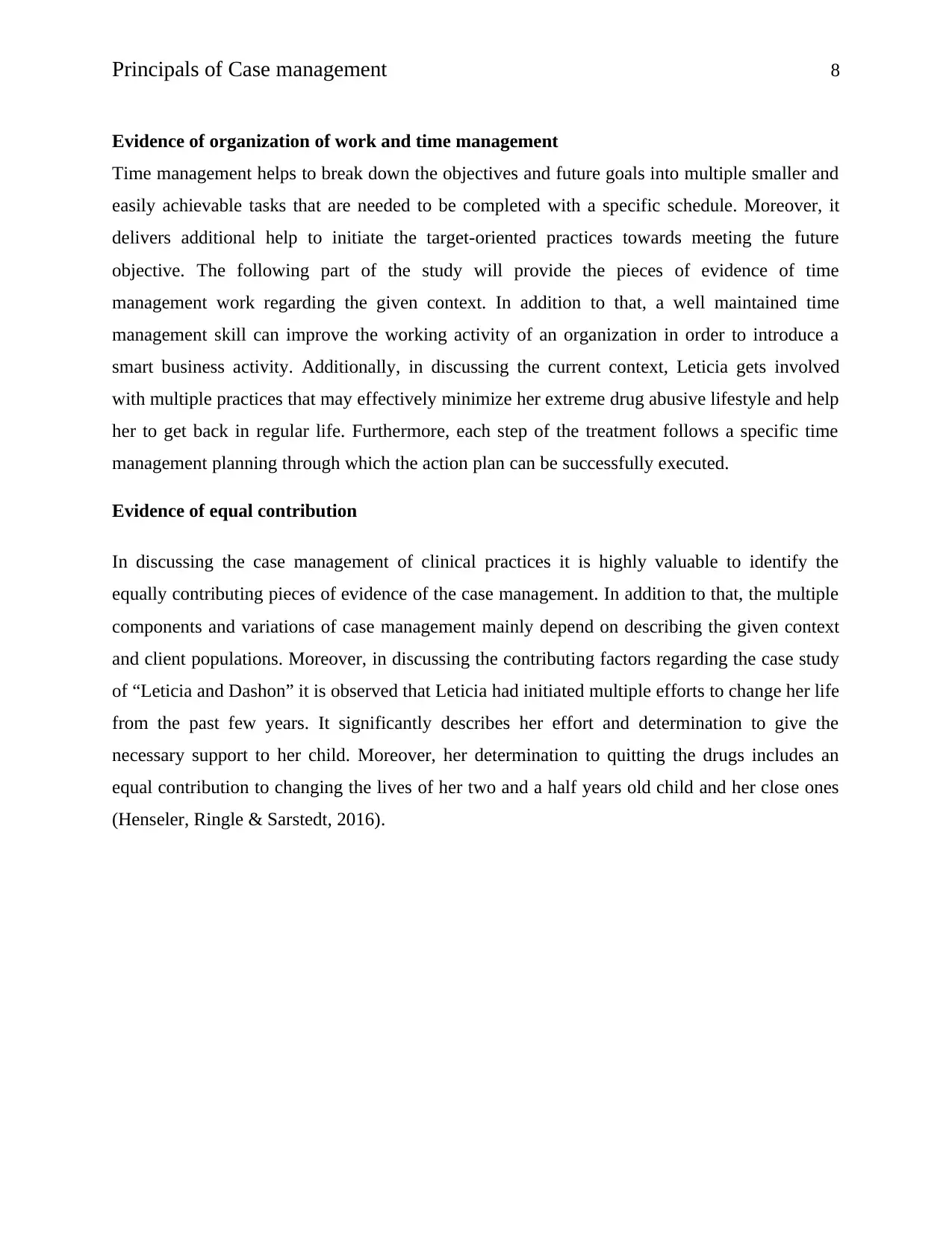
Principals of Case management 8
Evidence of organization of work and time management
Time management helps to break down the objectives and future goals into multiple smaller and
easily achievable tasks that are needed to be completed with a specific schedule. Moreover, it
delivers additional help to initiate the target-oriented practices towards meeting the future
objective. The following part of the study will provide the pieces of evidence of time
management work regarding the given context. In addition to that, a well maintained time
management skill can improve the working activity of an organization in order to introduce a
smart business activity. Additionally, in discussing the current context, Leticia gets involved
with multiple practices that may effectively minimize her extreme drug abusive lifestyle and help
her to get back in regular life. Furthermore, each step of the treatment follows a specific time
management planning through which the action plan can be successfully executed.
Evidence of equal contribution
In discussing the case management of clinical practices it is highly valuable to identify the
equally contributing pieces of evidence of the case management. In addition to that, the multiple
components and variations of case management mainly depend on describing the given context
and client populations. Moreover, in discussing the contributing factors regarding the case study
of “Leticia and Dashon” it is observed that Leticia had initiated multiple efforts to change her life
from the past few years. It significantly describes her effort and determination to give the
necessary support to her child. Moreover, her determination to quitting the drugs includes an
equal contribution to changing the lives of her two and a half years old child and her close ones
(Henseler, Ringle & Sarstedt, 2016).
Evidence of organization of work and time management
Time management helps to break down the objectives and future goals into multiple smaller and
easily achievable tasks that are needed to be completed with a specific schedule. Moreover, it
delivers additional help to initiate the target-oriented practices towards meeting the future
objective. The following part of the study will provide the pieces of evidence of time
management work regarding the given context. In addition to that, a well maintained time
management skill can improve the working activity of an organization in order to introduce a
smart business activity. Additionally, in discussing the current context, Leticia gets involved
with multiple practices that may effectively minimize her extreme drug abusive lifestyle and help
her to get back in regular life. Furthermore, each step of the treatment follows a specific time
management planning through which the action plan can be successfully executed.
Evidence of equal contribution
In discussing the case management of clinical practices it is highly valuable to identify the
equally contributing pieces of evidence of the case management. In addition to that, the multiple
components and variations of case management mainly depend on describing the given context
and client populations. Moreover, in discussing the contributing factors regarding the case study
of “Leticia and Dashon” it is observed that Leticia had initiated multiple efforts to change her life
from the past few years. It significantly describes her effort and determination to give the
necessary support to her child. Moreover, her determination to quitting the drugs includes an
equal contribution to changing the lives of her two and a half years old child and her close ones
(Henseler, Ringle & Sarstedt, 2016).
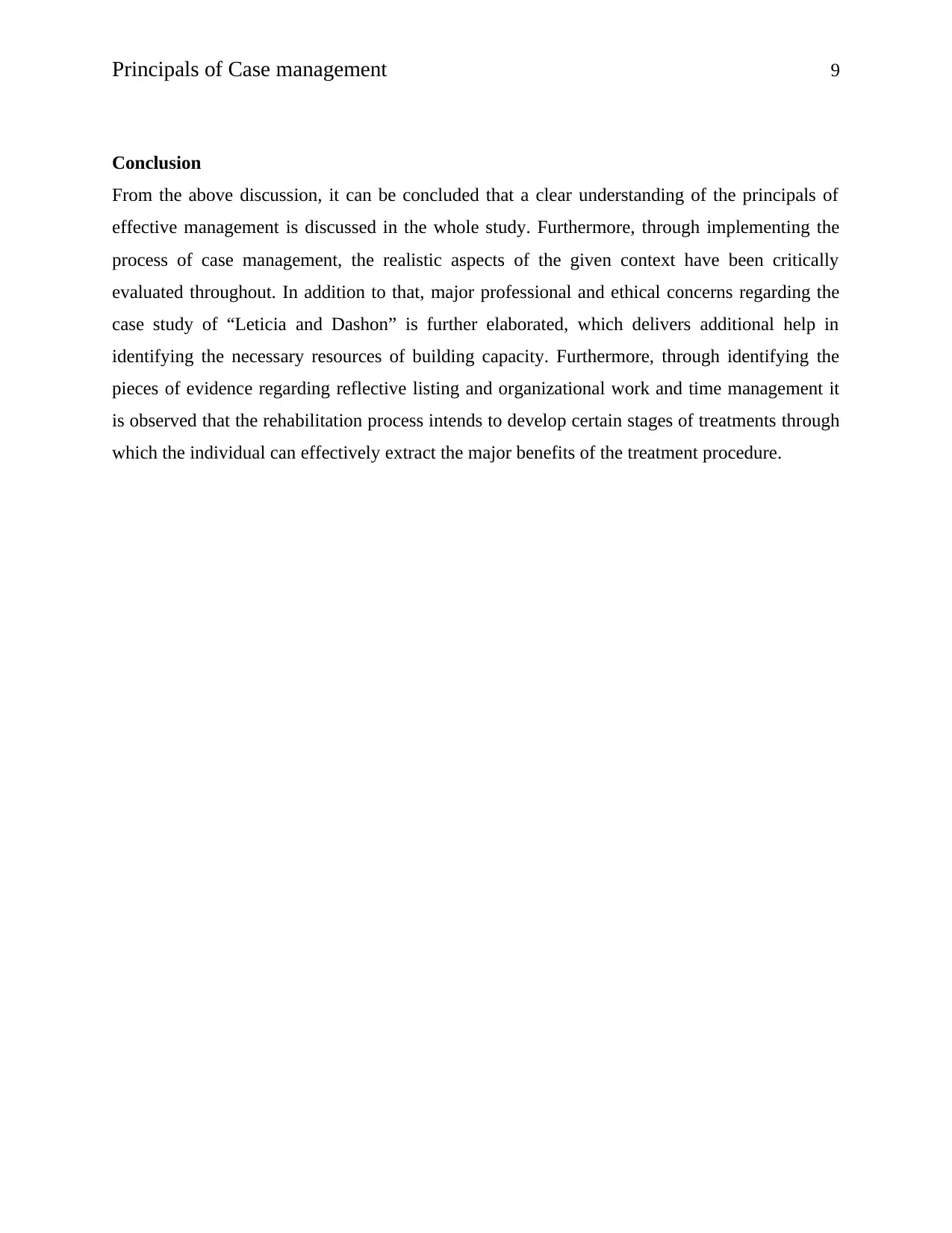
Principals of Case management 9
Conclusion
From the above discussion, it can be concluded that a clear understanding of the principals of
effective management is discussed in the whole study. Furthermore, through implementing the
process of case management, the realistic aspects of the given context have been critically
evaluated throughout. In addition to that, major professional and ethical concerns regarding the
case study of “Leticia and Dashon” is further elaborated, which delivers additional help in
identifying the necessary resources of building capacity. Furthermore, through identifying the
pieces of evidence regarding reflective listing and organizational work and time management it
is observed that the rehabilitation process intends to develop certain stages of treatments through
which the individual can effectively extract the major benefits of the treatment procedure.
Conclusion
From the above discussion, it can be concluded that a clear understanding of the principals of
effective management is discussed in the whole study. Furthermore, through implementing the
process of case management, the realistic aspects of the given context have been critically
evaluated throughout. In addition to that, major professional and ethical concerns regarding the
case study of “Leticia and Dashon” is further elaborated, which delivers additional help in
identifying the necessary resources of building capacity. Furthermore, through identifying the
pieces of evidence regarding reflective listing and organizational work and time management it
is observed that the rehabilitation process intends to develop certain stages of treatments through
which the individual can effectively extract the major benefits of the treatment procedure.
⊘ This is a preview!⊘
Do you want full access?
Subscribe today to unlock all pages.

Trusted by 1+ million students worldwide
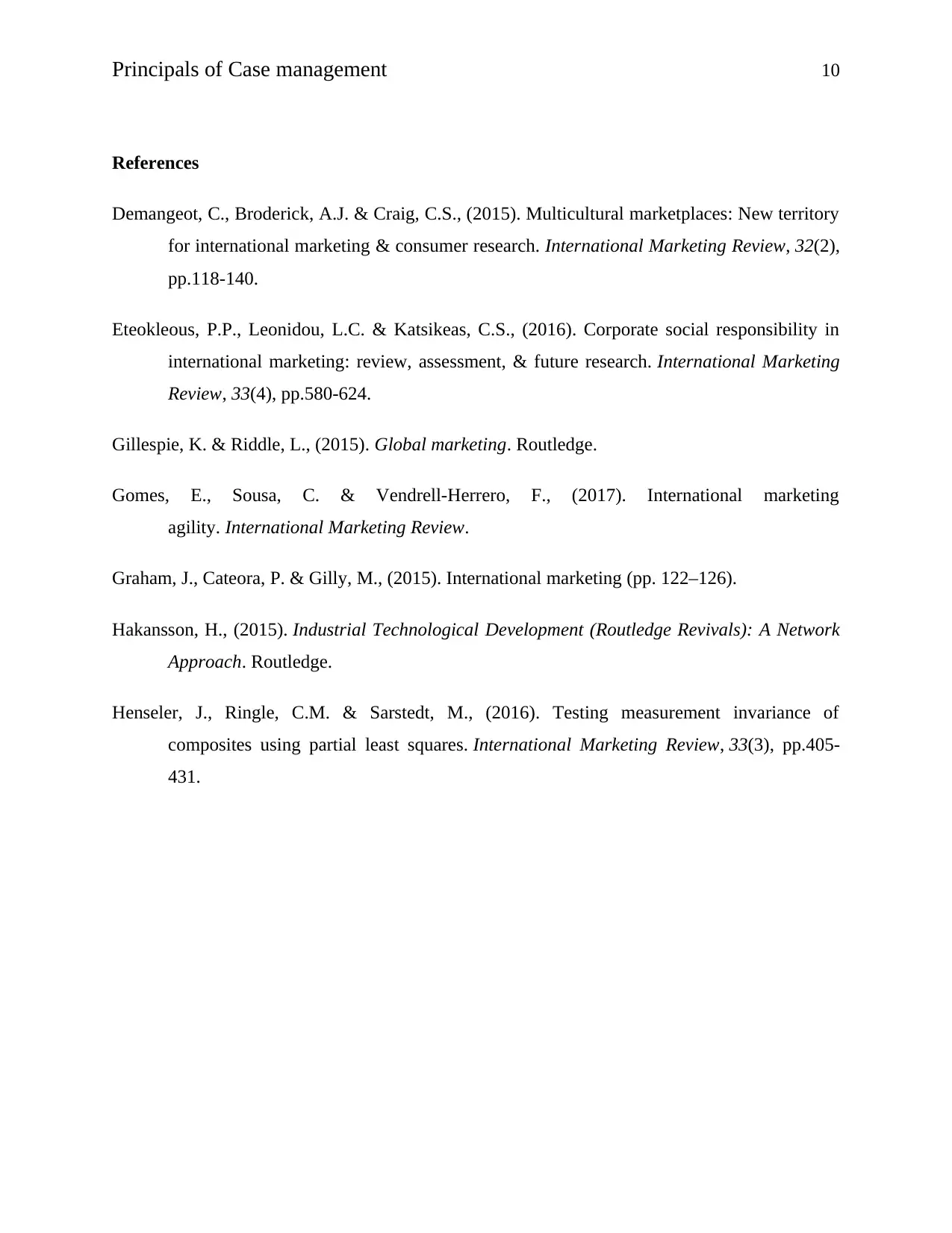
Principals of Case management 10
References
Demangeot, C., Broderick, A.J. & Craig, C.S., (2015). Multicultural marketplaces: New territory
for international marketing & consumer research. International Marketing Review, 32(2),
pp.118-140.
Eteokleous, P.P., Leonidou, L.C. & Katsikeas, C.S., (2016). Corporate social responsibility in
international marketing: review, assessment, & future research. International Marketing
Review, 33(4), pp.580-624.
Gillespie, K. & Riddle, L., (2015). Global marketing. Routledge.
Gomes, E., Sousa, C. & Vendrell-Herrero, F., (2017). International marketing
agility. International Marketing Review.
Graham, J., Cateora, P. & Gilly, M., (2015). International marketing (pp. 122–126).
Hakansson, H., (2015). Industrial Technological Development (Routledge Revivals): A Network
Approach. Routledge.
Henseler, J., Ringle, C.M. & Sarstedt, M., (2016). Testing measurement invariance of
composites using partial least squares. International Marketing Review, 33(3), pp.405-
431.
References
Demangeot, C., Broderick, A.J. & Craig, C.S., (2015). Multicultural marketplaces: New territory
for international marketing & consumer research. International Marketing Review, 32(2),
pp.118-140.
Eteokleous, P.P., Leonidou, L.C. & Katsikeas, C.S., (2016). Corporate social responsibility in
international marketing: review, assessment, & future research. International Marketing
Review, 33(4), pp.580-624.
Gillespie, K. & Riddle, L., (2015). Global marketing. Routledge.
Gomes, E., Sousa, C. & Vendrell-Herrero, F., (2017). International marketing
agility. International Marketing Review.
Graham, J., Cateora, P. & Gilly, M., (2015). International marketing (pp. 122–126).
Hakansson, H., (2015). Industrial Technological Development (Routledge Revivals): A Network
Approach. Routledge.
Henseler, J., Ringle, C.M. & Sarstedt, M., (2016). Testing measurement invariance of
composites using partial least squares. International Marketing Review, 33(3), pp.405-
431.
1 out of 10
Related Documents
Your All-in-One AI-Powered Toolkit for Academic Success.
+13062052269
info@desklib.com
Available 24*7 on WhatsApp / Email
![[object Object]](/_next/static/media/star-bottom.7253800d.svg)
Unlock your academic potential
Copyright © 2020–2025 A2Z Services. All Rights Reserved. Developed and managed by ZUCOL.



